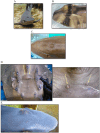Case report: Endolymphatic system disease in elasmobranchs: clinical presentation, diagnosis, and treatment strategies
- PMID: 40129653
- PMCID: PMC11931651
- DOI: 10.3389/fvets.2024.1463428
Case report: Endolymphatic system disease in elasmobranchs: clinical presentation, diagnosis, and treatment strategies
Abstract
The inner ear is an often overlooked system in elasmobranchs with few documented reports of disease or other abnormalities in the literature. Similar to terrestrial vertebrates, it is located in the cranium, and there are multiple components to the ear of elasmobranchs including a pair of membranous labyrinths each with three semicircular canals and four chambers or end organs (the saccule, the lagena, the utricle and the macula neglecta) making up the endolymphatic system (ELS). There is species variability among the inner ear anatomy of elasmobranchs, and this may play a role in disease development, progression, and treatment outcomes. Also similar to terrestrial vertebrates, this system plays a key role in hearing, acceleration, and orientation. When affected, clinical signs may include localized areas of swelling or stoma development along the dorsal midline of the head at the endolymphatic pores, atypical swimming behaviors consistent with vestibular disease (spiraling/spinning or barrel rolling, or tilting to one side), and anorexia. Less frequently, the eyes may also be affected and present with exophthalmia, hyphema, and/or panophthalmitis. Herein are case series from five institutions representing a variety of elasmobranch species affected with ELS disease with discussion of anatomy, clinical presentation, diagnostics, etiology, treatment, and outcomes. Endolymphatic disease may be clinically underdiagnosed in elasmobranchs and mistaken for other diseases such as superficial subcutaneous or subdermal abscesses, focal dermatitis, or neuropathies presumed to not be associated with the inner ear system. In addition, disease may be occult for a long period of time prior to overt manifestation of signs or chronic with waxing and waning clinical signs, likely because of anatomy and resultant treatment challenges. Awareness and additional research may help to promote timely identification, improve diagnostic and treatment options, and help to optimize individual animal welfare.
Keywords: endolymphatic pore; inner ear; labyrinthitis; neurologic disease; neuropathy; otic disease; shark; stingray.
Copyright © 2025 Greene, Pereira, Doescher, Rojo-Solis, David, Faustino, Reese, De Voe, Latson and Mylniczenko.
Conflict of interest statement
RD-V and NM were employed by The Walt Disney Company. NP was employed by Sea Life Park Hawaii. The remaining authors declare that the research was conducted in the absence of any commercial or financial relationships that could be construed as a potential conflict of interest.
Figures










Similar articles
-
Quantitative assessment of inner ear variation in elasmobranchs.Sci Rep. 2023 Jul 24;13(1):11939. doi: 10.1038/s41598-023-39151-0. Sci Rep. 2023. PMID: 37488259 Free PMC article.
-
Remarks on the inner ear of elasmobranchs and its interpretation from skeletal labyrinth morphology.J Morphol. 2001 Dec;250(3):236-64. doi: 10.1002/jmor.1068. J Morphol. 2001. PMID: 11746463
-
Interspecific Variation in the Inner Ear Maculae of Sharks.Integr Org Biol. 2023 Sep 4;5(1):obad031. doi: 10.1093/iob/obad031. eCollection 2023. Integr Org Biol. 2023. PMID: 37732173 Free PMC article.
-
Brain and inner-ear fluid homeostasis, cochleovestibular-type tinnitus, and secondary endolymphatic hydrops.Int Tinnitus J. 2006;12(1):75-81. Int Tinnitus J. 2006. PMID: 17147045 Review.
-
Delayed endolymphatic hydrops as a clinical entity.Int Tinnitus J. 2004;10(2):137-43. Int Tinnitus J. 2004. PMID: 15732511 Review.
References
-
- Pereira N, Nunes GD, Baylina N, Peleteiro MC, Rosado L. Fusarium solani infection in the eye, brain, otic capsule and endolymphatic tubes in captive port Jackson sharks (Heterodontus portusjacksoni). In: Proceedings of the 33rd annual conference of the International Association for Aquatic Animal Medicine; (2002). p. 54-6.
-
- Pereira N, Faustino R, Faísca P, Veríssimo C, David H, Baylina N. Twenty years later: a new case of endolymphatic tube infection, internal otitis and meningitis caused by Fusarium Solani in a port Jackson shark (Heterodontus Portusjacksoni). In: Proceedings of the International Association for Aquatic Animal Medicine (IAAAM) meeting and conference (2018).
Publication types
LinkOut - more resources
Full Text Sources

